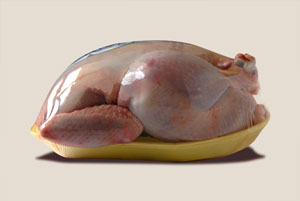 Whether you’re a grill aficionado or you only pull out your miniature Weber for special occasions, it’s important to eat plenty of protein as part of a balanced diet. While most nutrition experts recommend eating lean meats, tofu, beans and quinoa, we often neglect those during the summertime in favor of grilled steaks, hot dogs and hamburgers.
Whether you’re a grill aficionado or you only pull out your miniature Weber for special occasions, it’s important to eat plenty of protein as part of a balanced diet. While most nutrition experts recommend eating lean meats, tofu, beans and quinoa, we often neglect those during the summertime in favor of grilled steaks, hot dogs and hamburgers.
Chicken is an easy alternative to red meat, which often has a lot of artery-clogging saturated fat. Chicken is versatile, grill-friendly and inexpensive, but when not handled or cooked properly, poultry can be a source of dangerous food borne illness.
Here are some important poultry-handling principles to follow this summer to ensure that all of your meals are safe and delicious.
Labeling Confusion:
Like most food labels, dating language on poultry products can be confusing for consumers. When you see a use-by date, it is mainly for quality assurance, as you can safely consume the product after this date but it will lessen in quality. If you see a sell-by date, it a recommendation for the store. Again, the product will be safe after the date but it’s quality may have already peaked. Always trust your instinct when it comes to a product’s safety – if something doesn’t look or smell right to you, it’s smarter to throw it out than to risk your health and safety.
Chill Out:
If you’re grilling outside, as is common in the summertime, complete all prep work indoors before removing the chicken from the refrigerator, which should be set at approximately 40 degrees F. Chicken should always be kept cold to prevent the growth of bacteria and maintain its shelf life. When you do remove chicken from the refrigerator, it should feel cold to the touch.
Defrosting 101:
The USDA Food Safety & Inspection Service (FSIS) says that there are three ways to safely defrost chicken: under cold running water, in the refrigerator or in the microwave. While some people think that setting it at room temperature will speed up the process, it also allows bacteria to grow more quickly. If you forget to take your chicken out to defrost in advance, you are better off cooking it frozen than thawing it at room temperature – just know it might take up to 50% longer to reach a safe temperature.
Always Cook to 165 degrees F:
The USDA recommends cooking any chicken or poultry product until it has reached a safe internal temperature of 165 degrees F (using a food thermometer). Whether you’re cooking in the oven or on the grill, you’ll always want to keep the chicken cooking until it hits that 165 degrees F goal.
